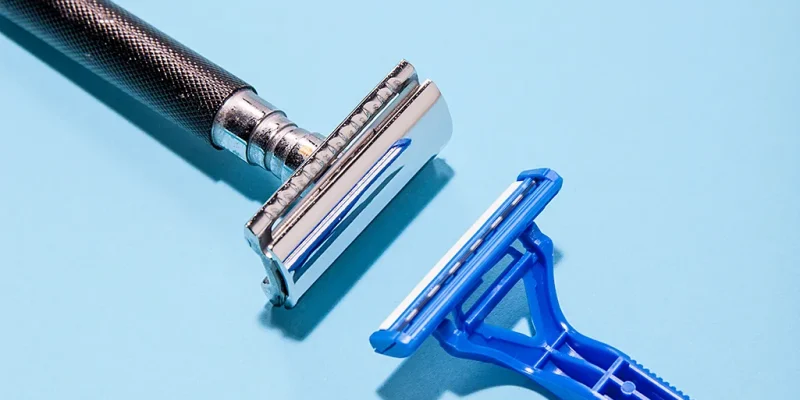Old School Razor: The Complete Guide to Vintage Shaving

In today’s world of electric shavers and multi-blade cartridges, many men and women are rediscovering the old school razor. Whether it’s the classic straight razor your grandfather used or the timeless safety razor, these tools represent more than just grooming—they’re a ritual, a piece of history, and often a path to a better shave.
So, what exactly is an old school razor? Generally, the term refers to:
- Straight razors (the traditional folding blade).
- Safety razors (introduced in the late 1800s).
- Vintage razors from classic brands like Gillette.
In this article, we’ll explore everything you need to know about old school razors: their history, benefits, how they compare to modern options, and tips for using and collecting them.
A Brief History of the Old School Razor
Straight Razors
- First appeared in the 17th century.
- Feature a single, sharp blade that folds into the handle.
- Known as the “cut-throat razor” due to the skill required.
- Barbers worldwide used them as the standard until the early 20th century.
Safety Razors
- Invented in the late 1800s as a safer alternative to straight razors.
- King Camp Gillette popularized the disposable blade safety razor in 1901.
- Became the standard for home shaving throughout the 20th century.
The Modern Shift
- Cartridge razors and electric shavers took over in the late 20th century.
- But now, there’s a renaissance in traditional wet shaving as people seek quality, sustainability, and style.
Types of Old School Razors
Straight Razor
- The oldest form of shaving razor.
- Provides the closest possible shave.
- Requires skill, patience, and regular maintenance.
- Often considered the ultimate “barber experience.”
Safety Razor
- Double-edge (DE) or single-edge design.
- Balances closeness with safety.
- Uses replaceable blades that are inexpensive and eco-friendly.
- Easier to learn than straight razors.
Vintage Collectible Razors
- Classic Gillette models (e.g., Gillette Fatboy, Tech, Slim).
- Antique straight razors with ornate handles.
- Popular among collectors and shaving enthusiasts.
Why Choose an Old School Razor?
- Closer Shave
A sharp single blade cuts hair at skin level, reducing stubble.
- Fewer Irritations
Multi-blade cartridges can tug and cause razor burn.
Old school razors use one sharp edge, minimizing skin damage.
- Eco-Friendly
Safety razor blades are recyclable.
Straight razors last a lifetime with proper care.
- Cost-Effective
Double-edge blades cost pennies compared to cartridge refills.
Straight razors require no ongoing blade purchases.
- Ritual and Style
Shaving becomes an art form, not a chore.
Many enjoy nostalgia and craftsmanship.
Old School Razor vs. Modern Razors
| Feature | Old School Razor | Modern Razor |
| Shave Quality | Extremely close | Good, but less precise |
| Learning Curve | High (especially straight razors) | Very low |
| Cost Over Time | Low | High (cartridge refills) |
| Eco-Friendly | Yes (recyclable/long-lasting) | No (plastic waste) |
| Style & Experience | Classic, ritualistic | Quick and utilitarian |
How to Use an Old School Razor
Straight Razor Shaving Steps
- Prep the Skin – Wash face with warm water and apply shaving cream.
- Hold Properly – Use a steady hand at a 30-degree angle.
- Short Strokes – Shave with the grain, then across, then against if desired.
- Rinse and Moisturize – Cool water rinse + aftershave balm.
Safety Razor Shaving Steps
- Load Blade – Insert double-edge blade.
- Lather Up – Use shaving soap and a brush for rich lather.
- Gentle Pressure – Let the weight of the razor do the work.
- Shave in Passes – With the grain, then across.
- Clean and Dry – Rinse razor thoroughly.
Maintenance of Old School Razors
- Straight Razor Care:
Regular stropping before each shave.
Honing every few months.
Keep the blade dry and oiled to prevent rust.
- Safety Razor Care:
Rinse after each use.
Disassemble and clean weekly.
Replace blade after 5–7 shaves.
Best Old School Razor Brands
- Straight Razors:
Dovo (Germany).
Boker.
Thiers-Issard (France).
- Safety Razors:
Merkur.
Edwin Jagger.
Vintage Gillette.
- Modern Makers of Classic Styles:
Parker.
Feather (Japan).
Collecting Old School Razors
Many enthusiasts collect vintage razors as a hobby.
What Makes a Razor Collectible?
- Age and rarity.
- Brand reputation (e.g., Gillette Fatboy).
- Condition (mint condition razors fetch higher prices).
- Unique materials (ivory, tortoiseshell, sterling silver).
Where to Find Them
- Antique shops.
- Online marketplaces (eBay, Etsy).
- Specialty shaving forums.
- Estate sales.
Old School Razor Accessories
- Shaving Brush: Traditionally made from badger or synthetic bristles.
- Shaving Soap/Cream: Creates protective lather.
- Strop: Leather strip for straight razors.
- Aftershave Balm: Soothes and hydrates skin.
- Razor Stand: Keeps safety razors dry and rust-free.
Common Mistakes with Old School Razors
- Applying too much pressure → cuts and irritation.
- Using a dull blade → tugging and discomfort.
- Skipping prep → dry shaving leads to razor burn.
- Not cleaning razor → bacteria buildup.
- Storing damp → leads to rust and blade damage.
Cost of Old School Razors
- Straight Razors: $70–$300+ (one-time investment).
- Safety Razors: $25–$150.
- Blades: $10–$20 for 100-pack.
- Vintage Collectibles: $100–$1,000+ depending on rarity.
While initial costs may be higher, the long-term savings are significant compared to disposable cartridges.
Why Old School Razors Are Making a Comeback
- Sustainability – Reducing plastic waste.
- Quality Shaving – Many find modern razors inferior.
- Personal Style – Retro grooming is trendy again.
- Self-Care Ritual – Turning shaving into a mindful experience.
Conclusion
The old school razor isn’t just a shaving tool—it’s a connection to tradition, craftsmanship, and mindful grooming. From straight razors that demand skill to safety razors that balance precision with ease, these timeless tools deliver a superior shave, long-term savings, and eco-friendly benefits.
Whether you’re an enthusiast, a collector, or someone tired of expensive cartridges, stepping back into the world of old school razors may be the upgrade your grooming routine needs.
FAQs
1. What is considered an old school razor?
Typically, straight razors and safety razors from earlier generations.
2. Are old school razors better than modern razors?
They offer a closer shave, less irritation, and lower long-term cost.
3. Is shaving with a straight razor dangerous?
It requires skill, but with proper technique it’s safe and effective.
4. Can women use old school razors?
Yes, safety razors and straight razors are suitable for both men and women.
5. Where can I buy an old school razor?
Online retailers, antique shops, and specialty shaving stores.
Also read: Prime Dent: 10 Incredible Benefits of Choosing Expert Dental Care











